Transcription rate of noncoding roX1 RNA controls local spreading of the Drosophila MSL chromatin remodeling complex
- PMID: 18793722
- PMCID: PMC2659721
- DOI: 10.1016/j.mod.2008.08.003
Transcription rate of noncoding roX1 RNA controls local spreading of the Drosophila MSL chromatin remodeling complex
Abstract
The dosage compensation complex in Drosophila is composed of at least five MSL proteins and two noncoding roX RNAs that bind hundreds of sites along the single male X chromosome. The roX RNAs are transcribed from X-linked genes and their RNA products "paint" the male X. The roX RNAs and bound MSL proteins can spread in cis from sites of roX transcription, but the mechanism controlling spreading is unknown. Here we find that cis spreading from autosomal roX1 transgenes is coupled to the level of roX transcription. Low to moderate transcription favors, and vigorous transcription abolishes local spreading. We constructed a roX1 minigene one third the size of wild type as a starting point for mutagenesis. This allowed us to test which evolutionarily conserved motifs were required for activity. One short repeat element shared between roX1 and roX2 was found to be particularly important. When all copies were deleted, the RNA was inactive and unstable, while extra copies seem to promote local spreading of the MSL complex from sites of roX1 synthesis. We propose that assembly of the MSL proteins onto the extreme 3' region of elongating roX1 transcripts determines whether the MSL complex spreads in cis.
Figures
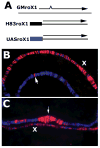
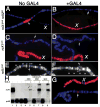

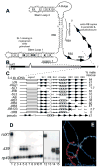
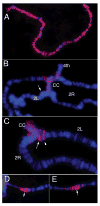
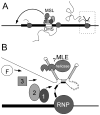
Similar articles
-
Autoregulation of the Drosophila Noncoding roX1 RNA Gene.PLoS Genet. 2012;8(3):e1002564. doi: 10.1371/journal.pgen.1002564. Epub 2012 Mar 15. PLoS Genet. 2012. PMID: 22438819 Free PMC article.
-
Extent of chromatin spreading determined by roX RNA recruitment of MSL proteins.Science. 2002 Nov 22;298(5598):1620-3. doi: 10.1126/science.1076686. Science. 2002. PMID: 12446910
-
Sequence-specific targeting of MSL complex regulates transcription of the roX RNA genes.EMBO J. 2004 Jul 21;23(14):2853-61. doi: 10.1038/sj.emboj.7600299. Epub 2004 Jul 1. EMBO J. 2004. PMID: 15229655 Free PMC article.
-
roX RNAs: non-coding regulators of the male X chromosome in flies.RNA Biol. 2009 Apr-Jun;6(2):113-21. doi: 10.4161/rna.6.2.8060. Epub 2009 Apr 3. RNA Biol. 2009. PMID: 19229132 Review.
-
Path to equality strewn with roX.Dev Biol. 2004 May 1;269(1):18-25. doi: 10.1016/j.ydbio.2004.01.039. Dev Biol. 2004. PMID: 15081354 Review.
Cited by
-
When Down Is Up: Heterochromatin, Nuclear Organization and X Upregulation.Cells. 2021 Dec 4;10(12):3416. doi: 10.3390/cells10123416. Cells. 2021. PMID: 34943924 Free PMC article. Review.
-
Dosage compensation in Drosophila melanogaster: epigenetic fine-tuning of chromosome-wide transcription.Nat Rev Genet. 2012 Jan 18;13(2):123-34. doi: 10.1038/nrg3124. Nat Rev Genet. 2012. PMID: 22251873 Review.
-
Drosophila dosage compensation: a complex voyage to the X chromosome.Development. 2009 May;136(9):1399-410. doi: 10.1242/dev.029645. Development. 2009. PMID: 19363150 Free PMC article. Review.
-
RNA-on-X 1 and 2 in Drosophila melanogaster fulfill separate functions in dosage compensation.PLoS Genet. 2018 Dec 10;14(12):e1007842. doi: 10.1371/journal.pgen.1007842. eCollection 2018 Dec. PLoS Genet. 2018. PMID: 30532158 Free PMC article.
-
msl2 mRNA is bound by free nuclear MSL complex in Drosophila melanogaster.Nucleic Acids Res. 2011 Aug;39(15):6428-39. doi: 10.1093/nar/gkr236. Epub 2011 May 6. Nucleic Acids Res. 2011. PMID: 21551218 Free PMC article.
References
Publication types
MeSH terms
Substances
Grants and funding
LinkOut - more resources
Full Text Sources
Molecular Biology Databases

